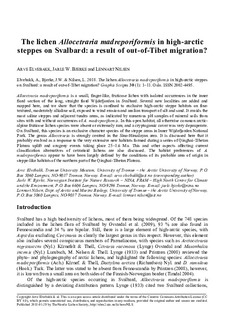| dc.description.abstract | The lichen Allocetraria madreporiformis in high-arctic steppes on Svalbard: a result of out-of-Tibet migration? ARVE ELVEBAKK, JARLE W. BJERKE and LENNART NILSEN Elvebakk, A., Bjerke, J.W. & Nilsen, L. 2018. The lichen Allocetraria madreporiformis in high-arctic steppes on Svalbard: a result of out-of-Tibet migration? Graphis Scripta 30 (1): 1–11. Oslo. ISSN 2002-4495. Allocetraria madreporiformis is a small, finger-like, fruticose lichen with isolated occurrences in the inner fiord section of the long, straight fiord Wijdefjorden in Svalbard. Several new localities are added and mapped here, and we show that the species is confined to exclusive high-arctic steppe habitats on fine-textured, moderately alkaline soil, exposed to wind erosion and aeolian transport of silt and sand. It avoids the most saline steppes and adjacent tundra areas, as indicated by numerous pH samples of mineral soils from sites with and without occurrences of A. madreporiformis. In this open habitat, all otherwise common arctic-alpine fruticose lichen species were absent or extremely rare, and a cryptogamic cover was very depauperate. On Svalbard, this species is an exclusive character species of the steppe areas in Inner Wijdefjorden National Park. The genus Allocetraria is strongly centred in the Sino-Himalayan area. It is discussed here that it probably evolved as a response to the very extensive new habitats formed during a series of Qinghai-Tibetan Plateau uplift and orogeny events taking place 25–1.6 Ma. This and other aspects affecting current classification alternatives of cetrarioid lichens are also discussed. The habitat preferences of A. madreporiformis appear to have been largely defined by the conditions of its probable area of origin in steppe-like habitats of the northern part of the Qinghai-Tibetan Plateau. | nb_NO |

